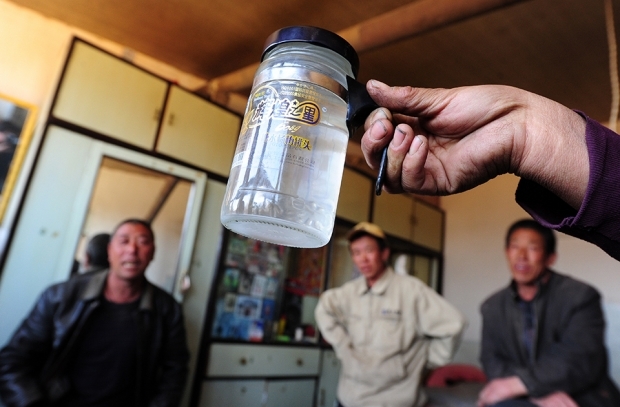Water flowing from the Xiang River into the faucets of Hunan Province homes has been dangerous for decades. The central government first classified the river’s water as toxic in the 1980s. But the river was being called the most polluted in China as early as 1978, years before heavy industry and manufacturing bases spread along its shores.
Today, experts say, the water is so concentrated with cancer-causing heavy metals that standard purification and treatment systems cannot protect the 40 million people living along the Xiang, including farmers, miners and urbanites in the factory city of Changsha.
And only last year did central government authorities take their first, cautious steps toward initiating a clean-up of the river, which begins in the scenic Guilin region and empties into the Yangtze River.
The effort began with testing: The Ministry of Housing and Urban-Rural Development commissioned the Hunan Provincial Center for Disease Control to test the output of water treatment plants across the province.
A source close to the Hunan Provincial People's Congress Environmental and Resources Protection Committee said the results were “far from ideal.” Details have not been released to the public.
Caixin recently visited the area where intake pipes draw water for the Xiangtan No. 1 Tap Water Plant in the city of the same name. A dog carcass floated nearby, and garbage piles lined the shore.
Zou Junliang, a general manager for the plant’s operator Xiangtan General Water, said benchmarks for water quality have been lowered over the years, and a lack of data from the past makes comparisons difficult. It’s hard for him to even describe the scope of the environmental disaster.
“Over so many years, the water’s source has deteriorated I don’t know how many times,” Zou said.
But public information from the Hunan Provincial Department of Environmental Protection and city environmental departments in Changsha, Xiangtan, and Zhuzhou offer plenty of evidence that any water drawn from the Xiang is heavily polluted from mines, factories, and cities. High levels of lead, manganese, cadmium, and other heavy metals have been detected in the Xiang since 1996, record show. Moreover in 2006 and 2007, more than 50 percent of the river water fell below the Category III quality level, which some experts said rendered it unfit for human consumption.
“Human sewage in the (river) continues to exceed standards,” said Li Ninghuai, deputy head of the Xiangtan water monitoring station. “Mercury, arsenic, cadmium and other heavy metals exceed standards due to discharges from upstream factories.”
Tsinghua University School of Environmental Sciences Professor Wang Zhansheng said tainted water can have detectable and invisible effects on a human body. Invisible hazards come from the effects of excessive organics in tap water that can lead to serious disease.
“Organic compounds accumulate in the human body and ultimately harm the body,” he said. “In severe cases, they can cause cancer, deformities and mutations.”
Meeting new, nationwide clean-water standards set to be introduced later this year appears unlikely along the Xiang, according to experts.
China’s new standards for drinking water are more stringent than those in the European Union. But Liu Wenjun, director of Tsinghua’s School of Environmental Sciences Institute of Drinking Water Safety, said simple clean-water technologies that purify urban supplies in the United States, Canada, and Australia cannot be applied on rivers such as the Xiang.
“Most of China’s water sources are polluted,” Liu said. “Current systems are too simple and just don’t work.”
That doesn’t mean the Chinese are giving up. Experts say fifteen to twenty years worth of work will be needed to clean the Xiang and other rivers. Efforts are already under way to upgrade water treatment plants with new technology.
Song Lanhe, chief engineer at the housing ministry’s Urban Water Supply Water Quality Monitoring Center, at least 20 percent of the nation’s water plants should launch projects to upgrade to advanced treatment processes as soon as possible. Advanced treatment processes include those that can remove organic and inorganic compounds.
To meet the new national water standards, Xiangtan General Water has invested more than 7 billion yuan in recent years to upgrade testing equipment. Zou said improving the water to protect the environment and human health “isn’t a problem on a technical level but a financing issue.”
Two water plants in Changsha already use advanced treatment processes, but others in the province do not.
Changsha’s plants are exceptional in China. As of 2009, 98 percent of the nation’s more than 4,000 major water treatment plants still used traditional cleaning processes. Other exceptions included plants serving Beijing, Shanghai, Guangzhou, Shenzhen, Hangzhou and Zhengzhou.
The need for better treatment on the Xiang has been especially apparent since 2008, the year a Zhuzhou smelting plant dumped a huge amount of cadmium-laced wastewater into the Xiangtan-Changsha section of the river. Lacking advanced technology, lime was used to in a vain attempt to clean up the mess.
Liu Hongqiao is a Caixin staff reporter.




